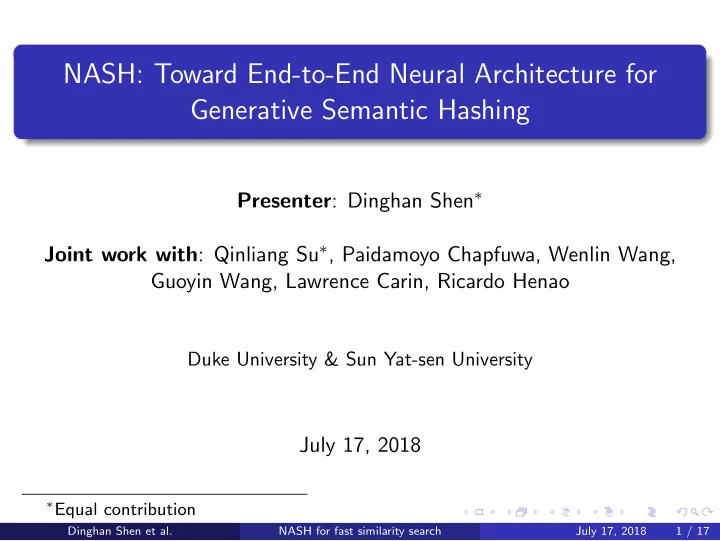

NASH: Toward End-to-End Neural Architecture for Generative Semantic Hashing Presenter : Dinghan Shen ∗ Joint work with : Qinliang Su ∗ , Paidamoyo Chapfuwa, Wenlin Wang, Guoyin Wang, Lawrence Carin, Ricardo Henao Duke University & Sun Yat-sen University July 17, 2018 ∗ Equal contribution Dinghan Shen et al. NASH for fast similarity search July 17, 2018 1 / 17
Background Semantic Hashing Fast and accurate similarity search (i.e., finding documents from a large corpus that are most similar to a query of interest ) is at the core of many information retrieval applications; One strategy is to represent each document as a continuous vector: such as Paragraph Vector [Le and Mikolov, 2014], Skip-thought vectors [Kiros et al., 2015], Infersent [Conneau et al., 2017], etc. Cosine similarity is typically employed to measure relatedness; Semantic hashing is an effective approach: the similarity between two documents can be evaluated by simply calculating pairwise Hamming distances between hashing (binary) codes; Dinghan Shen et al. NASH for fast similarity search July 17, 2018 2 / 17
Motivation & contributions Motivation: Existing semantic hashing approaches typically require two-stage training procedures (e.g. continuous representations are crudely binarized after training); Vast amount of unlabeled data is not fully leveraged for learning binary document representations. Contributions: we propose a simple and generic neural architecture for text hashing that learns binary latent codes for documents, which be trained an end-to-end manner; We leverage a Neural Variational Inference (NVI) framework, which introduces data-dependent noises during training and makes effective use of unlabeled information. Dinghan Shen et al. NASH for fast similarity search July 17, 2018 3 / 17
Recommend
More recommend